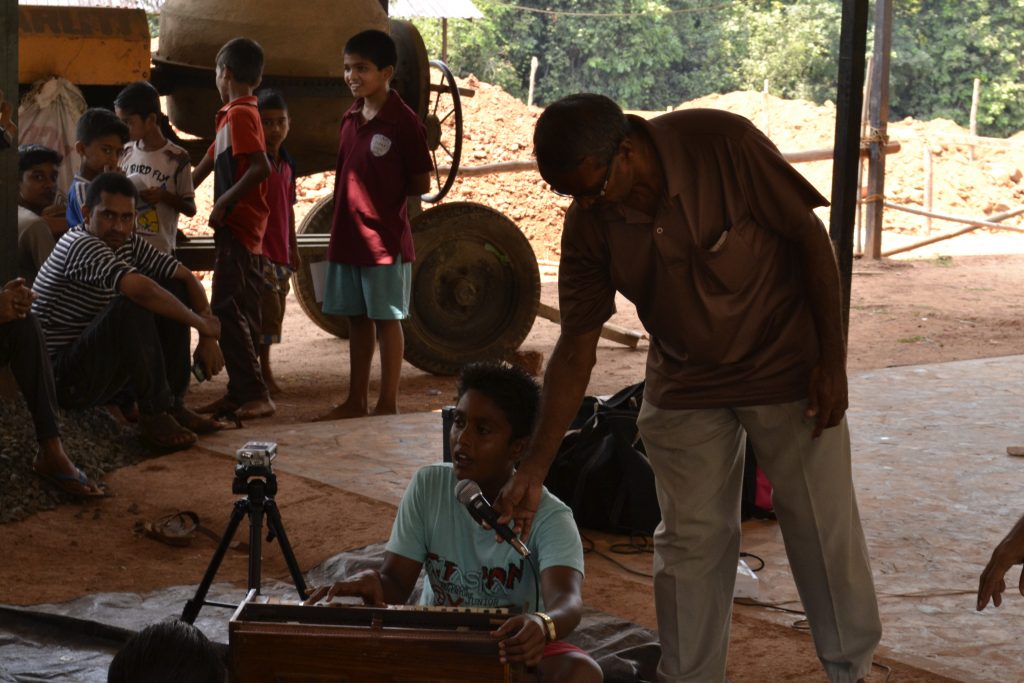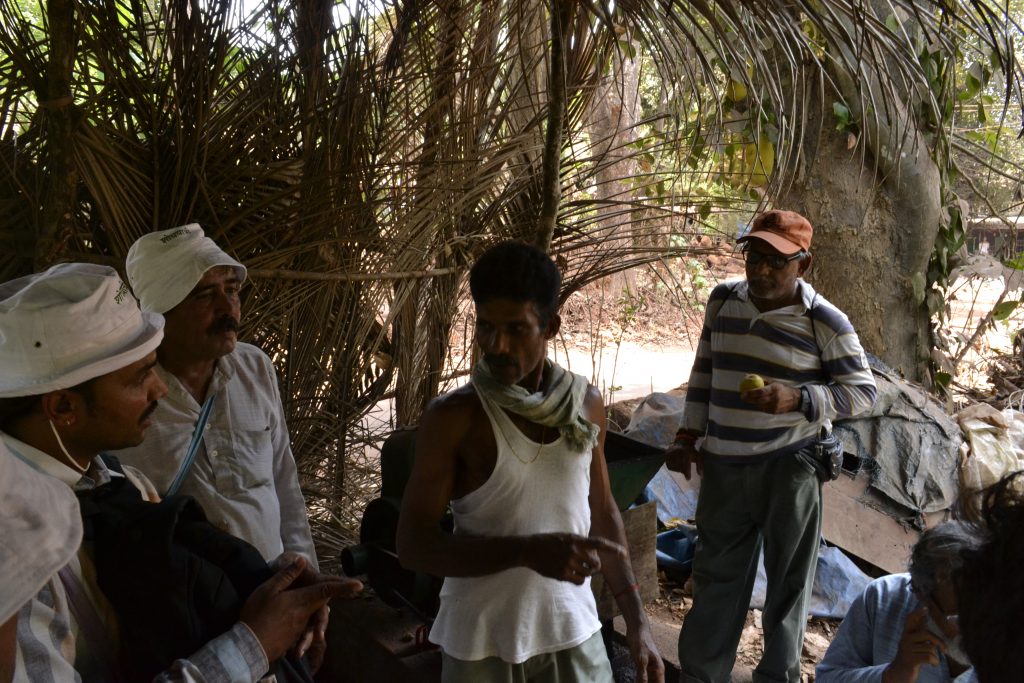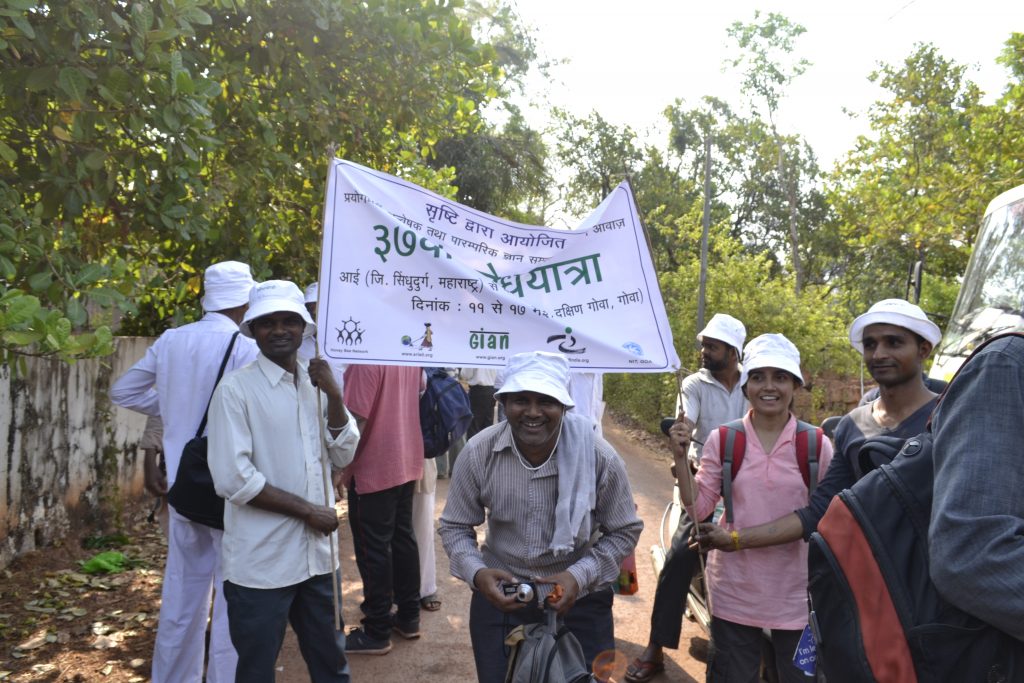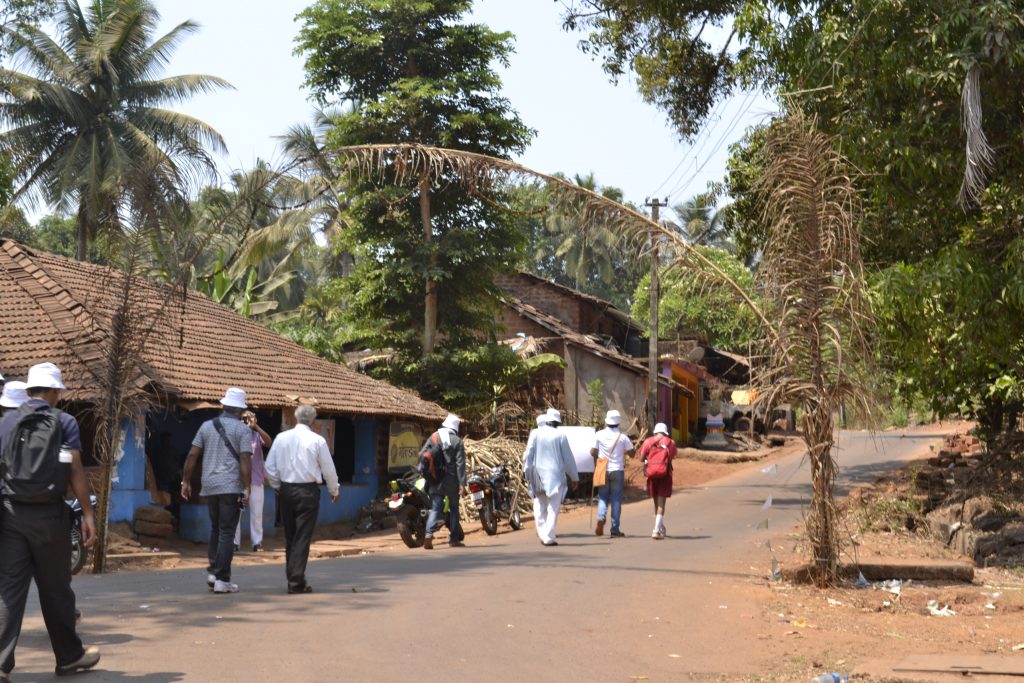Get Next Shodhyatra Update:
Phone:
079-27913293, 27912792
Email:
info@sristi.org
37TH SHODHYATRA - AYEE (MAHARASHTRA TO COLAMB - GOA)
DIVERSITY OF CULTURE AND COLOURS, THY NAME IS GOA
The cultural richness of Goa is evident in so many institutions, imbued as they are, with diverse beliefs joyful celebration of everything a colourful life offers. What remained as an indelible memory with the fellow walkers, the shodhyatris, was an amazingly diverse tapestry of colorful houses, a beautiful pot of tulsi plant infront of the house, and extremely warm traditions of hospitality. It did not matter which religious beliefs one followed, neighborhood solidarity was apparent in every stopover for food, or meetings yatris had during the 37th Yatra. It was ironic that a state with so many estuaries, rivers and waterbodies should have pockets of habitations struggling to get enough water every day. Mining has taken its toll in disrupting underground and in some places surface water flows. A potpourri of different cultures, cuisines, creative crafts and innovative traditions discovered during Goa Shodhyatra, organised by SRISTI, May 11-17, 2016, Ayee, Sindhudurg district, Maharashtra to Colamb, South Goa district are being shared here.
Diversity and warmth are deeply embedded in Goa’s culture. Here, every rural house tends to be different in colour and architecture. One such incident of goodwill towards strangers is worth recalling. One of the yatris was fatigued after hours of walking and needed to be dropped at the next night-halt shelter several kilometers away. Chetan, the coordinator of the yatra, requested a young motorcycle rider, who happened to be passing by, to give a lift to the yatri. The stranger not only dropped the yatri but also informed Chetan on his way back that he had done so. Goa is truly a place of warmth, cooperation and tremendous respect for strangers.
Fourteen cultural communities stayed together amiably in Ayee village where all the yatris from different parts of the country met. Situated on the border of Maharashtra-Goa, the village offered an encounter with innovators and rich tradition knowledge holders. Ramchandra Rathor, a serial inventor, had modified the carburettor of an engine to run it on biogas many years ago. Observing that water in garden hosepipe lying in hot sun for a while, gets heated, he made a simple solar water heater with an array of water pipes fitted across an iron frame. When one fills in water from the bottom, hot water comes out from the top. A low-cost, do-it-yourself approach to affordable frugal innovation is the way forward according to him. How well had he captured the essence of the Honey Bee Network’s philosophy!
Some of the yatris shared their experience of meeting an extraordinary craftsman, Vijaydutta Lotlikar, outside of Goa earlier. He makes handicrafts using coconut shell. His collection is a record of its kind, registered with the Guinness Book. Using coconut shells, he manufactures over 450 different household products such as water bottles, diyas (lamps) and showpieces. He has made a unique collection of over 500 crosses of different designs, some very small in size. He studied designs Rama Velip of crosses after visiting cemeteries, churches, and also from photographs he could collect from around the world. Cross-cultural appreciation of this kind characterises the secular and sacred traditions of Goa. He sells coconut shell buttons to a design school at ₹26 per piece and teaches the craft to young people. Air Asia Airlines is one of his customers. Lotlikar avoids participating in crafts fair where his pupils do because he doesn’t want that his excellence to become a drag on the sales of his disciples. In a slightly different context Ravi J Mathai, the first director of IIM Ahmedabad, had set a principle of governance at the institute wherein the director was not supposed to compete with faculty for consultancy or other projects. These are values permeating our culture at different levels in formal and informal institutions.
In an idea competition at Dharnagarwad village, Divya Dixit and several other students came up with an idea of toothpaste dispenser, akin to a soap dispenser. Navin, Pratham and other boys suggested that unless license is inserted in the socket, a car should not start. A similar idea had been recognised during the IGNITE competition by National Innovation Foundation earlier but these little children were unaware of that. It was heartening to see that children everywhere, from Tripura to Goa, have similar creative potential. They only need a helping hand and mentorship to be able to aim at new horizons.
Laxmiben, a lambada artist, had migrated from Kolhapur to make iron tools. We stopped by on the way to find out about the kind of orders they received. They not only repaired and fabricated farm tools but also took some other orders of grills, gates and other household fixtures. As yatris moved on, Kheer, a milk pudding of ripened jackfruit, was served to along with sol kadhi—an after-food digestive drink made of buttermilk, garlic, and kokum fruit. The yatris had never tasted such dishes. The architecture and design of the colourful houses of Goa showed an enduring influence of the Portuguese culture. The colourful houses were indeed a sight to behold. Vivid structural designs in the tribal as well as more developed settlements impressed everyone. Sanjeev Patil in South Goa, has created a system that allows a person to switch off the motor remotely from anywhere. He plans to create an automatic water-feeder for animals too, where one simply needs to place a bucket in front of an animal. He has an organic farm in which he wishes to take only five percent biomass out of the farm and leave the rest for recycling. This diverse garden is a model for neighboring farmers.
Another innovator, Suresh Naykar alias Sukur has improved the clutch system of bikes, including the bullet which has helped increase mileage while reducing the maintenance costs. We met him in roadside workshop when we just casually stopped by out of curiosity.
The yatris were introduced to recipes that used local varieties of rice. The benefits are endless, such as aiding in ailments like diabetes, alleviating stomach painsand indigestion, maintaining physical strength, overall fitness and well-being. Moreover, some of the local rice varieties are particularly helpful at the time of childbirth. Local women informed the yatris about an edible preparation of peanuts, jackfruit seeds and pulses that is not only loved for its taste but also for its cultural value. It is prepared during festivals and is used as a religious offering during various rituals. The yatris noticed a delicacy that was prepared using colocasia (aaruna) leaves as well as banana stem and flowers. A woman made a delicacy using raw, unprocessed cashew nuts with very little oil which was incredibly tasty, apart from being highly nutritious.
In Bimbal village, Komal presented food art — an art using an amalgam of several vegetables. She shared her artistic skills with several other villagers. She belongs to Karnataka and shifted to Bhimol after her marriage. This is a classic example of diffusion of artistic knowledge through migration. Sadanand and Sunanda Desai organised a meeting of local herbalists. Mimosa pudica (touch me not) plant was reported for treating ulcers and acidity (also reported in literature). Chirayata (Swertia chirata) was reported for treating stomach ache by Surekha Tulsidas Desai. Komal Desai, Khanapur, daughter in law of the house, originally from a region on the border of Karnatakagoa, showcased beautiful edible fruit and vegetable art. SRISTI would invite her to future Sattvik Traditional Food Festival to share her art work with local learners.
In the local cuisine, there is extensive use of coconut. Tender coconut, dry coconut and coconut water are used in various forms. Kokum is extensively used. Another distinctive experience for the yatris was eating cucumber halva. This is quite unusual and reflects unique diversity in cuisines. The rich culinary knowledge has been passed from generation to generation and forms a part of the rich cultural heritage.
The yatris observed folk art, sculptures and crafts created from clay and bamboo. They also saw different sculptures made of coconuts and betel nuts, husk and other parts of the palms. There is a conscious effort to preserve their culture and heritage, both through handicrafts and household practices.
Every day was unique in this journey, which included walks through forests and highways filled with unending line of trucks carrying mined iron ore. But, the journey was also about social conversations. Rama Velip, a tribal social activist, narrated the hurdles he had to overcome in his fight to protect forests with the mining companies of Goa. His petition in Supreme Court supported by many civil society organisations had led to banning of mining for three years. The mining has been reopened recently. There were twelve criminal cases were filed against him. His entry was banned in mines. He alleged that mine owners plant acacia, eucalyptus and teak instead of native tree species so that getting permission for mining did not pose problems. Forest department reportedly permitted conversion of land use if acacia kind of trees were growing on a piece of land. Rama Vellip was also concerned about increasing of asthma and other diseases among mine workers.
The yatris also heard anxious accounts of how climate change was affecting the production of cashew; how the youth is not interested in farming anymore.
Most women, whom the yatris interacted with, also looked after their paddy fields and cashew plantation on their own. They also collect wood for fuel and actively take part in constructing their houses. However, ones living next to big towns like Ponda depended more on the market for their daily needs. The women are relatively confident here and do not shy away from interacting with strangers – a sign of cultural maturity.
Goan villagers seem satisfied, generous and some of the community members are also a bit laidback. Most often, the cashews, kokum and mango trees, in and around the villages, are left with fruits unharvested. At the same time, they shared fruits with the yatris while they walked through these villages. One of them saw one yatri collecting fallen unripened mangoes on the roadside. He took out more matures one from his house and gifted the same to the yatris.
Most children understand english and were found to be creative. One such child made unique multiple designs from the used wrappers of mouth fresheners. Others made decorative flowers from fruits like water melon. The teachers include different and innovative ways of teaching at schools. The walls of schools are painted with lessons and messages which aid good values in children.
Almost, all houses have tulsi pots in front of their houses in vivid designs. However, many of the houses had not watered the plants and they were drying out. Many places had temples but, with
few people. Not many religious events or festivals are celebrated here.
The elderly of the villages shared that the younger generation is getting more into the taxi business, taking tourists to spots like Dudhsagar waterfalls and nearby places. Some even own trucks and ferry mined ore or processed cashew. Owning trucks/taxi has become one of the aspirational destinations of many rural youth. Which other seeds of desires will extensive mining spawn? If one cannot stop it, ‘join it’ seems to be a popular refrain.
Infrastructure is quite unevenly distributed in some parts of the state. Some settlements integrated into nearby urban localities, while others are totally cut-off and have to rely on municipality tankers that come every two days while some have piped water supply, with installed meters. Interestingly, yatris observed phone numbers mentioned In many public places for people to complain if there was anything wrong with the water meter or piped water supply.
The yatris learnt a new technique of germination: adding coconut husk to the soil, wetting it with water, covering the soil with cow dung and then allowing the maize seeds to germinate. The seedlings are later transplanted. This technique gives strength and immunity to the seeds at the germination stage itself. Transplantation of maize seedling is not a common practice anywhere in the world. Though scientists have been doing trial on this technique during the last decade in different countries.
Though the health facilities or chemist shops were not found prominently, people seemed to be healthy, despite poor sanitation. Most houses had toilets and bathrooms next to their kitchen.
Walking along the mining area, the yatris couldn’t help but think how detrimental it must be for the people working and living in these areas. We noticed a few people wearing masks and others without protection. Mining is the main industry in this state. It did trigger economic growth in the mining regions. The panchayat office in most places were very well built.
The influence of mining and other industries in buying out local leadership was mentioned by several community members in a regretful tone. The yatris noticed that people try all sorts of things, ranging from guns to scarecrows to keep monkeys off their fruits. People here leave their houses open and don’t have sturdy gates. Whenever the yatris went to a house, they would have to call out or knock two to three times before someone would show up (all this while the gates were open).
The walk through forests had a calming effect on yatris. Unlike walking on pucca roads, where you feel tired, walking through the forest did not tire yatris.
Colamb was the last leg of the shodhyatra. Fresh water flowing from the rocks is used for drinking. Down the stream, one would notice people bathing and washing clothes. It was disturbing to see plastic waste in water. The scenario broke the reverie the yatris had been in, and everybody wondered what could be done to change people’s indifferent behaviour towards waste.
Balwant, the driver of NIF’s innovation bus regretted that he could not walk since he had to drive mobile exhibition bus. Most other yatris shared what they learned not only from yatra but also from SRISTI team members like Chetan who had prepared for it months in advance.
The support from the students of NIT Goa was very much appreciated by the yatris, some of the best meetings with local communities took place in villages where the students were involved. While there were a lot of developmental issues that local communities will have to resolve, shodhyatris learned deeply that Goa was not just about beaches and dances. The composite culture had many lessons to teach to the rest of the country.
FLICKR GALLERY










